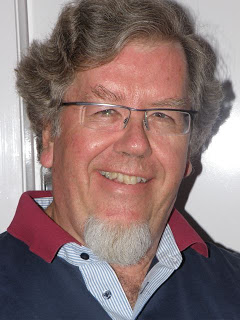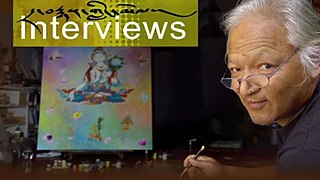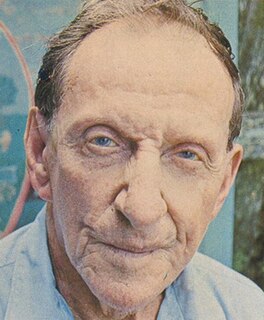Related Research Articles

Rosaleen Miriam Norton, who used the name of Thorn, was a New Zealand-born Australian artist and occultist, in the latter capacity adhering to a form of pantheistic / Neopagan Witchcraft largely devoted to the mythological Greek god Pan. She lived much of her later life in the bohemian area of Kings Cross, Sydney, leading her to be termed the "Witch of Kings Cross" in some of the tabloids, and from where she led her own coven of Witches.
Davida Frances Allen is an Australian painter, filmmaker and writer.
Gordon Bennett was an Australian artist of Aboriginal and Anglo-Celtic descent. Born in Monto, Queensland, Bennett was a significant figure in contemporary Indigenous Australian art.
Vivienne Joyce Binns is an Australian artist known for her contribution to the Women's Art Movement in Australia, her engagement with feminism in her artwork, and her active advocacy within community arts. She works predominantly in painting.
Harry James "HJ" Wedge was a Wiradjuri artist.

Gil Jamieson was an Australian painter. Jamieson was born in the central Queensland town of Monto in 1934 and died there in 1992.

Nevill Drury was an English-born Australian editor and publisher, as well as the author of over 40 books on subjects ranging from shamanism and western magical traditions to art, music, and anthropology. His books have been published in 26 countries and in 19 languages.
Bob Jenyns is a prolific Australian artist whose practice, spanning over four decades, has produced countless sculptures, prints, drawings, and paintings. He has participated in many of Australia's most significant art exhibitions including the first Biennale of Sydney (1973), the 1973, 1975 and 1978 Mildura Sculpture Triennials, the 1981 Australian Perspecta, the 2nd Australian Sculpture Biennale, and the 1990 Sculpture Triennial. Jenyns was a finalist in the 2006 Helen Lempriere National Sculpture Award, and in 2007 won the award with his work Pont de l'archeveche. He is represented in many of the country's largest collections, including the National Gallery of Australia, the Art Gallery of New South Wales, the Queensland Art Gallery, the Museum of Contemporary Art in Brisbane, and the Tasmanian Museum and Art Gallery. Jenyns has also received multiple grants from the Australia Council's Visual Arts Board, has curated exhibitions and has taught at the Tasmanian School of Art as head of the sculpture department (1982–2005).

Stewart Angus MacFarlane, is a figurative Australian painter. His style is a pared-down realism combined with a surreality of lighting and perspective. He often, though not always, places a female or male nude in a situation of erotic enigma. He paints the Australian scene representative of Western society as a whole.
Rodney Armour Milgate was an Australian painter and playwright. He was a Professor of the Visual Arts School of the (then) City Art Institute, University of NSW and newsreader.

Karma Phuntsok is a Tibetan painter.
Jennifer Herd is an Australian Indigenous artist with family ties to the Mbar-barrum people of North Queensland. She is a founding member of the ProppaNOW artist collective, and taught at the Queensland College of Art in Brisbane, where she convened both the Bachelor of Fine Art and Contemporary Australian Indigenous Art. In 2003 she won the Queensland College of Art Graduate Students prize, the Theiss Art Prize, for her Masters of Visual Arts.
Carol McGregor is an Indigenous Australian artist of Wathaurung (Victoria) and Scottish descent, internationally known for her multi media installation pieces bringing together ephemeral natural fibres, metal, and paper. She is also deeply engaged in the creation of and cultural reconnection to possum skin cloaks, a traditional form of dress and important biographical cultural item.
Ann Thomson is an Australian painter and sculptor. She is best known for her large-scale public commissions Ebb Tide (1987) for the Sydney Convention and Exhibition Centre and Australia Felix (1992) for the Seville World Expo. In 1998 she won the [Art Gallery of New South Wales' Wynne Prize. Her work is held in national and international collections, including: the National Gallery of Australia, Canberra; Art Gallery of New South Wales, Sydney, Newcastle Art Gallery, Newcastle, Thyssen-Bornemisza Collection, Madrid and Villa Haiss Museum, Germany.
Anne Wallace is an Australian painter. Her works have appeared in major exhibitions and are held in major collections.

Charles Callins was an Australian naïve painter from Queensland.
The Australian Flying Arts School is a not-for-profit organisation that supports lifelong engagement in the visual and media arts throughout regional and remote Queensland. It was founded in 1971 by Mervyn Moriarty, who flew his plane more than 400,000 km (250,000 mi) over the next 12 years to visit remote areas of Queensland and deliver art education. Moriarty's Flying Arts, Gertrude Langer's Arts Council of Queensland and Arthur Creedy's Cultural Activities Department are credited with sparking the creation of private galleries and regional centres for the visual arts throughout Queensland.
Alick Tipoti, whose traditional name is Zugub, is a Torres Strait Islander artist, linguist, and activist of the Kala Lagaw Ya people, from Badu Island, in the Zenadh Kes. His work includes painting, installations, printmaking, sculpture and mask-making, and is focused on preserving the culture and languages of his people.
Donald Mackenzie Ross (1917-2015) was an Australian artist and former dentist, based in Brisbane, Queensland, known for his iconic jewellery and the mosaic mural in the crypt beneath the Shrine of Remembrance, Anzac Square, Brisbane. He was a key figure in the Brisbane artistic and craft scene for the entire second half of the 20th century, working across several different media – prints, pen and ink, oils, silver, gold, enamel, bronze and mosaics.
Sandra Leveson, also known as Sandra Leveson-Meares, is an Australian painter, printmaker, and teacher.
References
- ↑ Drury, 1992, p.14
- ↑ The Sydney Morning Herald | Good Weekend,"Bogey Man", Ed.p.2
- ↑ Hewitt, 1991, p.66
- ↑ The Brisbane Courier Mail,17.February 1995,P.1
- ↑ Hewitt,1991,p.66
- ↑ Wilson,1993
- ↑ Anderson,1993,p.10
- ↑ Adams,1993, pp.27,28,29
- ↑ Anderson,1993,p.10
- ↑ Saint Martin,1993, p.5
- ↑ Hoffie, 2004
- ↑ Saint Martin, Ann : "The Tyranny of Distance" Cairns RAG Newsletter, January 1993,p.5
- ↑ Anderson,1998, p.40
- ↑ Drury, 1993, p.14